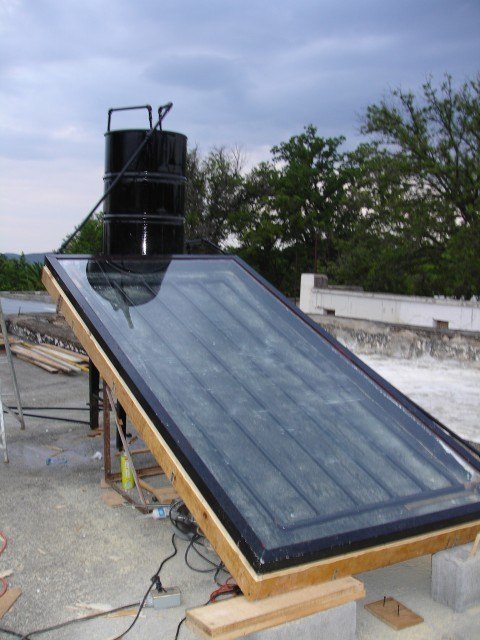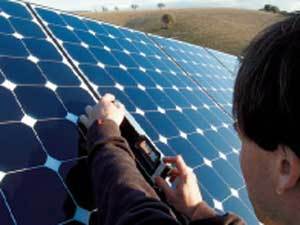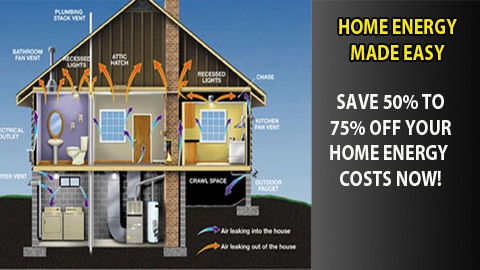Click Video to Watch
Course Summary: Solar Water Heater
An investment in a solar water heater will beat the stock market any day, any decade, risk free. Initial return on investment is on the order of 15 percent, tax-free, and goes up as gas and electricity prices climb.

Solar Water Heating
Hot water represents the second largest energy consumer in American households. A typical 80 gallon (300 l) electric hot water tank serving a family of four will consume approximately 150 million BTUs in its seven year lifetime. This will cost approximately US$3,600 (at US$0.08 per KWH), not counting for fuel cost increases, or the cost of the unit itself. Then it will be replaced by another one just like it.
Hmm. Maybe we should rethink this...

An investment in a solar water heating system will beat the stock market any day, any decade, risk free. Initial return on investment is on the order of 15 percent, tax-free, and goes up as gas and electricity prices climb.
Many states have tax credits and other incentives to sweeten those numbers even more. Forget the stock market. If you have invested in a house, your next investment should be in solar hot water.
Solar water heaters—also called solar domestic hot water systems—can be a cost-effective way to generate hot water for your home. They can be used in any climate, and the fuel they use—sunshine—is free.
How They Work
Solar water heater systems include storage tanks and solar collectors. There are two types of solar water heating systems: active, which have circulating pumps and controls, and passive, which don't.
Most solar water heaters require a well-insulated storage tank. Solar storage tanks have an additional outlet and inlet connected to and from the collector. In two-tank systems, the solar water heater preheats water before it enters the conventional water heater. In one-tank systems, the back-up heater is combined with the solar storage in one tank.
Three types of solar collectors are used for residential applications:

- Flat-plate collector
Glazed flat-plate collectors are insulated, weatherproofed boxes that contain a dark absorber plate under one or more glass or plastic (polymer) covers. Unglazed flat-plate collectors—typically used for solar pool heating—have a dark absorber plate, made of metal or polymer, without a cover or enclosure.

- Integral collector-storage systems
Also known as ICS or batch systems, they feature one or more black tanks or tubes in an insulated, glazed box. Cold water first passes through the solar collector, which preheats the water. The water then continues on to the conventional backup water heater, providing a reliable source of hot water. They should be installed only in mild-freeze climates because the outdoor pipes could freeze in severe, cold weather.
- Evacuated-tube solar collectors

They feature parallel rows of transparent glass tubes. Each tube contains a glass outer tube and metal absorber tube attached to a fin. The fin's coating absorbs solar energy but inhibits radiative heat loss. These collectors are used more frequently for U.S. commercial applications.
There are two types of active solar water heating systems:
- Direct circulation systems
Pumps circulate household water through the collectors and into the home. They work well in climates where it rarely freezes.
- Indirect circulation systems
Pumps circulate a non-freezing, heat-transfer fluid through the collectors and a heat exchanger. This heats the water that then flows into the home. They are popular in climates prone to freezing temperatures.
Passive solar water heater systems are typically less expensive than active systems, but they're usually not as efficient. However, passive systems can be more reliable and may last longer. There are two basic types of passive systems:
- Integral collector-storage passive systems
These work best in areas where temperatures rarely fall below freezing. They also work well in households with significant daytime and evening hot-water needs.
Thermosiphon System

A typical thermosiphon system is indicated in the diagram below. As the sun shines on the collector, the water inside the collector flow-tubes is heated.
As it heats, this water expands slightly and becomes lighter than the cold water in the solar storage tank mounted above the collector. Gravity then pulls heavier, cold water down from the tank and into the collector inlet. The cold water pushes the heated water through the collector outlet and into the top of the tank, thus heating the water in the tank.
A thermosiphon system requires neither pump nor controller. Cold water from the city water line flows directly to the tank on the roof. Solar heated water flows from the rooftop tank to the auxiliary tank installed at ground level whenever water is used within the residence.
This solar water heater system features a thermally operated valve that protects the collector from freezing. It also includes isolation valves, which allow the solar system to be manually drained in case of freezing conditions, or to be bypassed completely.
Solar water heater systems almost always require a backup system for cloudy days and times of increased demand. Conventional storage water heaters usually provide backup and may already be part of the solar system package.
A backup system may also be part of the solar collector, such as rooftop tanks with thermosyphon systems. Since an integral-collector storage system already stores hot water in addition to collecting solar heat, it may be packaged with a demand (tank less or instantaneous) water heater for backup.
Selecting a Solar Water Heater

Before you purchase and install a solar water heating system, you want to do the following:
- Consider the economics of a solar water heating system
- Evaluate your site's solar resource
- Determine the correct system size
- Determine the system's energy efficiency
- Estimate and compare system costs
- Investigate local codes, covenants, and regulations.
For information about specific solar water heater models and systems, see the Product Information resources listed on the right side of this page (or below if you've printed the page).
Installing and Maintaining the System
The proper installation of solar water heaters depends on many factors. These factors include solar resource, climate, local building code requirements, and safety issues; therefore, it's best to have a qualified, solar thermal systems contractor install your system.
After installation, properly maintaining your system will keep it running smoothly. Passive solar water heater systems don't require much maintenance. For active systems, discuss the maintenance requirements with your system provider, and consult the system's owner's manual.
Plumbing and other conventional water heating components require the same maintenance as conventional systems. Glazing may need to be cleaned in dry climates where rainwater doesn't provide a natural rinse.
Regular maintenance on simple systems can be as infrequent as every 3–5 years, preferably by a solar contractor. Systems with electrical components usually require a replacement part after or two after 10 years.
A solar water heater is one of the best investments a home owner can make to start saving almost instant money.
Downloads/Resources (Click to view or right click to download)
Checklists, Cheat sheets,...






